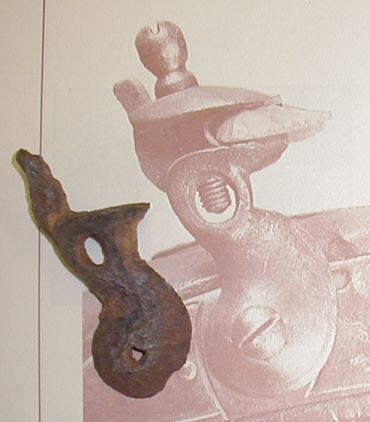
![]()
George Ranch Historical Park - Texian Market Days at the George Ranch HHistorical Park will be held Friday, October 23, 2009 for school children and Saturday, October 24, 2009 for the general public. The Fort Bend Archeological Society will host a dig site on the property for both days.
 The house, known to us now as the “Old Prairie Home”, was then the headquarters for what would become the George Ranch. Eleven years after the house burned, Albert and Mamie George, Polly Ryon’s granddaughter, built their first home together on the original grounds of the Old Prairie Home. Today, archeologists continue to uncover the remains of the original house that burned. Previous digs have recovered fragments of the Ryon family’s pottery, tableware, buttons, window glass, nails, and other remains of the ruined house. The excavated remains may someday be used to help plan the reconstruction and furnishing of the Old Prairie Home.
The house, known to us now as the “Old Prairie Home”, was then the headquarters for what would become the George Ranch. Eleven years after the house burned, Albert and Mamie George, Polly Ryon’s granddaughter, built their first home together on the original grounds of the Old Prairie Home. Today, archeologists continue to uncover the remains of the original house that burned. Previous digs have recovered fragments of the Ryon family’s pottery, tableware, buttons, window glass, nails, and other remains of the ruined house. The excavated remains may someday be used to help plan the reconstruction and furnishing of the Old Prairie Home.
Each year, the Fort Bend Archeological Society opens an excavation unit in the yard of the current George Ranch House. Society members are on hand to demonstrate basic archeological techniques and answer questions. Visitors to the excavation site are invited to pick up a trowel and join the dig. All excavations are real, the Society never plants artifacts. The excavation is open to both children and adults. For their help, children who sign up with a parent receive a certificate as archeologists for the day. Artifacts that are found are cleaned and then analyzed at the FBAS laboratory. Each year, our returning participants are delighted to see their past discoveries on display. Join the archaeologists and spend a few minutes or a few hours with the society...it's your best excuse to get dirty!

The archeological dig for children at the Henry Jones Old Prairie Home site (41FB277) continues to be very successful. Not only did FBAS have over 200 children partake in the two-day excavation last year, but many interesting artifacts and features were discovered. Working alongside FBAS volunteers last year, children recovered fragments of pottery, glass beads, buttons, window glass, bone, shell and nails.

Other remains of the ruined house such as an intact 3" square ceramic fireplace tile may someday be used to help plan the reconstruction and furnishing of the Old Prairie Home. One feature included large pieces of fieldstone arranged in a pattern just below the surface of the ground. Recently, pits were opened in the southwest corner of the yard where new research conducted by the Ranch suggested a corner of the old home may have been.
Two Significant Artifacts
In August of 2000, two significant artifacts excavated from the Jones Old Prairie Home site were discovered in the laboratory. Both are musket cocks identified by Michael Moore, director of the Fort Bend Museum. The first one was found during the Texian Market Days excavation in 1995. A university student working on the collection noticed the unusual looking and badly rusted piece of metal while cataloging all of the artifacts from the Prairie Home site. Electrolytic cleaning allowed it to be tentatively identified as part of an East India Pattern, Mexican Army Musket (pictured on the right) (Koury, Michael J., Arms for Texas: A Study of the Weapons of the Republic of Texas. Colorado: The Old Army Press, 1973, p. 6). The other was found during the 1998 excavation. Even though badly corroded, it still can be tentatively identified as from a Model 1816 U.S. Flintlock Musket (pictured on the left) (ibid., p. 11-13). Both are military firearms.


Several explanations could account for these artifacts on the site. They may just be trash, parts from obsolete guns thrown in the garbage pile when they were no longer needed. Michael Moore remarked that oftentimes those weapons were retrofitted with percussion firing mechanisms, and the cock would be discarded. Or they may have been abandoned during the Runaway Scrape, as colonists fled the George Ranch lands from the pursuing Mexican Army. However, the accidental loss or intentional discard of two of these weapons within a domestic space, and within a hundred feet of each other is uncanny. The historical record suggests a more plausible, and more exciting explanation.
A.J. Sowell’s History of Fort Bend County (1904) includes a brief entry about the Prairie Home. “They (Henry Jones and family) came back over the battlefield of San Jacinto . . . Some of the Jones boys picked up scopets and sabers and brought them home. These relics were lost when the Henry Jones homestead was burned in 1888 . . . the guns and swords had been left there in the garrett” (p.57). The musket cocks represent the most common firearms that each army carried at the battle of San Jacinto.
![]()
![]()